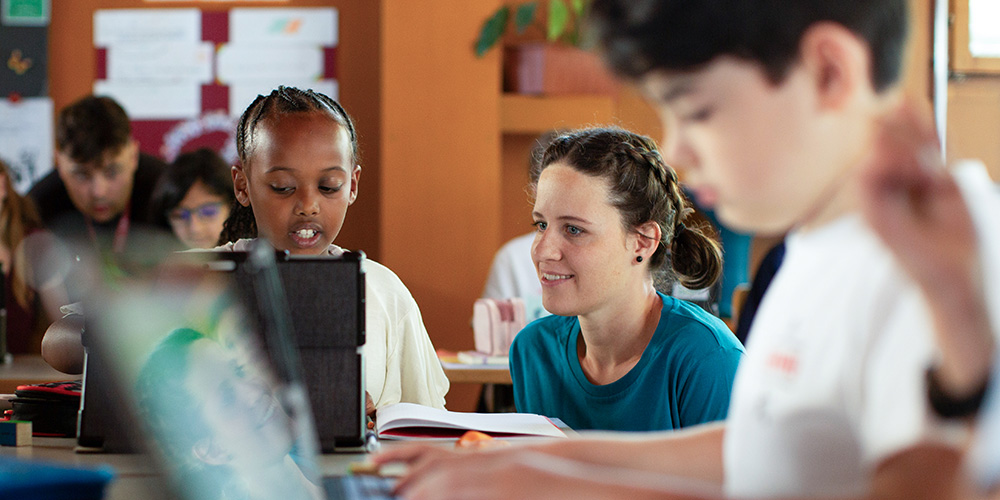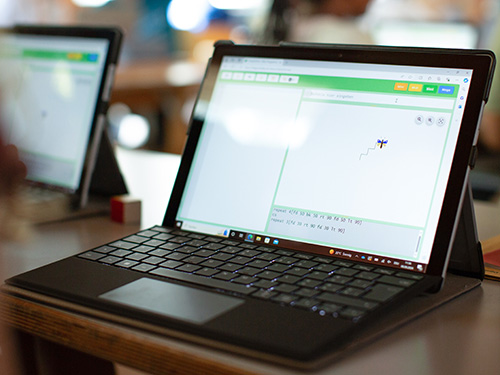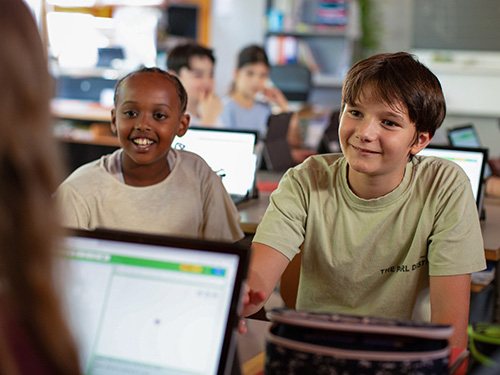The ABCs of programming.
Text: Samanta Siegfried
For almost 10 years, the PrimaLogo project has given Basel schoolchildren the chance to learn to program in primary school. The project simultaneously acts as continuing education for teachers.
A pupil in a pink hoodie types the following on her laptop keyboard: “repeat 4, open square brackets, fd 100 rt 90 fd 100 rt 90”. After entering a few more combinations, she closes the brackets and presses the enter key, causing a small butterfly on the screen to draw four squares in a row. “I did it!” the girl says with a broad smile.
It’s a Friday morning in September, and Class 5B at Brunnmatt School in Basel is learning to make repeated patterns appear on a computer screen. For the pupils, this is their third double period as part of the University of Basel’s PrimaLogo project, which has been running since 2015 with a view to teaching primary school children how to code. Over a period of 10 weeks, computer science students — or sometimes alumni — from Basel University visit schools in Basel-Stadt and Baselland to guide fifth- and sixth-graders through their classes.
Choreography for the mascot.
On this occasion, it’s Rebecca Dold and her assistant Till Küng who are standing before the pupils. “When programming repeated or recurring patterns, such as four squares in a row or a staircase, then it helps us to use something like a recipe. In mathematics and computer science, that’s called an algorithm,” says Dold as she draws patterns on the board: squares variously aligned and squares that make a type of staircase. The children attempt to program these patterns on their laptops for themselves.
For this, they use “Logo”, a programming language developed specially for children, who “feed” a mascot such as a turtle, butterfly or gecko with commands so that they then draw the corresponding patterns on the screen. Over and over, the children practice drawing the patterns in the air with their fingers before they start using the keyboard. As the pupils work, Dold and Küng walk around the classroom to help with any questions.
A look inside the black box.
“Logo is designed to be highly play-focused and delivers an immediate sense of achievement,” says Nadine Fröhlich, who coordinates PrimaLogo for the University of Basel. Since the project began, it has reached over 300 school classes, 260 teachers and therefore over 6,000 children in the cantons of Basel-Stadt and Baselland.
Fröhlich, who studied computer science herself and obtained a doctorate from Basel University, is confident of the value of this early contact with programming: “Many things in our everyday environment are programmed,” she says. Cars, watches, cellphones, information screens. It’s important for society to see behind the scenes, “so that it doesn’t remain a black box.”
”Moreover, she says that programming helps children practice various key skills, such as accuracy and patience, as well as how to identify a problem and solve it step by step.
Although the “Media and IT” module is part of the curriculum, many teachers apparently have reservations about the subject — and PrimaLogo therefore also acts as continuing education for teaching staff. “Since the classes are led by students, the teachers receive training at the same time and gain insights into how to teach the content,” says Fröhlich. Before the project begins, they also receive a three-and-a-half-hour crash course in which they learn the basic principles.
Rhea Schenker, the teacher of Class 5B, PrimaLogo was the first time she had in-depth contact with computer science. “When I graduated from the School of Education in 2012, the subject wasn’t part of the course yet — unlike today.”
Now, Schenker has already accompanied several classes through PrimaLogo and plans to incorporate the content into her Media and IT lessons once the project is over. “Motivation among the children is generally very high,” she says.
The high level of motivation is also apparent in this double period. “I like that the animals always do what I want,” says one pupil. “If you’ve done it right,” adds the girl sitting next to him. “You have to concentrate, otherwise you’ve got no chance!”
The women are catching up.
Rebecca Dold, who has been part of the PrimaLogo team for seven years, says: “There are always children who struggle with math but who are brilliant when it comes to programming.” She says this is partly because they approach programming with an open mind and haven’t had any good or bad experiences with it yet.
Dold doesn’t notice a difference between the sexes. Indeed, she says that female and male pupils are equally interested in the programming language and successful at learning it. Project manager Nadine Fröhlich is keen to emphasize that: “If you start too late with programming, the result is often that only boys are enthusiastic about it.”
When Fröhlich was a student, only 8 out of 100 students at bachelor’s level were female. Today, the ratio of women to men is a bit more balanced (45 women to 172 men at bachelor’s level), but there’s still a long way to go. “PrimaLogo could also help in this regard,” says Fröhlich.
When the bell rings for lunch break, the children were starting to lose concentration a little, and it takes a while for them to gather up their laptops and exercise books. Rebecca Dold and Till Küng bid farewell until the following week, when they will once again draw a series of shapes with the help of butterflies, turtles and other animal friends.
More articles in this issue of UNI NOVA (November 2024).



